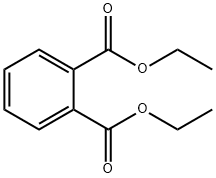CHEMICAL AND PHYSICAL PROPERTIES
| Physical Description | Diethyl phthalate appears as a clear, colorless liquid without significant odor. More dense than water and insoluble in water. Hence sinks in water. Primary hazard is to the environment. Spread to the environment should be immediately stopped. Easily penetrates soil, contaminates groundwater and nearby waterways. Flash point 325 °F. Severely irritates eyes and mildly irritates skin. Used in the manufacture of perfumes, plastics, mosquito repellents and many other products. |
|---|---|
| Color/Form | Colorless oily liquid |
| Odor | Practically odorless |
| Taste | Bitter disagreeable taste |
| Boiling Point | 568 °F at 760 mmHg (NTP, 1992) |
| Melting Point | 27 °F (NTP, 1992) |
| Flash Point | 284 °F (NTP, 1992) |
| Solubility | less than 1 mg/mL at 66 °F (NTP, 1992) |
| Density | 1.12 at 68 °F (USCG, 1999) - Denser than water; will sink |
| Vapor Density | 7.66 (NTP, 1992) - Heavier than air; will sink (Relative to Air) |
| Vapor Pressure | 1 mmHg at 227.8 °F ; 5 mmHg at 285.3 °F (NTP, 1992) |
| LogP | log Kow = 2.47 |
| Stability/Shelf Life | STABLE TO LIGHT |
| Autoignition Temperature | 855 °F (USCG, 1999) |
| Decomposition | When heated to decomp it emits acrid smoke and irritating fumes. |
| Viscosity | 31.3 centistokes at 0 °C |
| Heat of Combustion | -10,920 BTU/LB= -6,070 CAL/G= -254X10+5 J/KG |
| Heat of Vaporization | 170 BTU/LB= 96 CAL/G= 4.0X10+5 J/KG |
| Surface Tension | 37.5 dynes/cm at 20 °C |
| Refractive Index | Index of refraction: 1.5002 at 25 °C/D |
| Collision Cross Section | 164.2 Ų [M+Na]+ |
| Kovats Retention Index | 1543 1549 1547.5 1550.9 1558 1584 1583 1561.87 1562.22 1563.47 1563.84 1569.25 1570.77 1572.65 1567 1568 1558 1551.1 1565 1568 1568 1581 1583 1565 1587 1546 1583 1555.2 1545 1546 1547 1550 1565 1578 1578 1578 1578 1578 1579 1582 1541 1556 1563 1569.5 1551 1548 1551 1559 1564 1547 1560 1563 1564 1559 271.9 271.04 272.56 |
| Other Experimental Properties | LIQUID-WATER INTERFACE TENSION: 16.27 DYNES/CM= 0.01627 N/M @ 20.5 °C |
| Chemical Classes | Plastics & Rubber -> Phthalate Esters |
SAFETY INFORMATION
| Signal word | Warning |
|---|---|
| Pictogram(s) |
 Health Hazard GHS08 |
| GHS Hazard Statements |
H361:Reproductive toxicity |
| Precautionary Statement Codes |
P201:Obtain special instructions before use. P202:Do not handle until all safety precautions have been read and understood. P280:Wear protective gloves/protective clothing/eye protection/face protection. P308+P313:IF exposed or concerned: Get medical advice/attention. P405:Store locked up. |
COMPUTED DESCRIPTORS
| Molecular Weight | 222.24 g/mol |
|---|---|
| XLogP3 | 2.5 |
| Hydrogen Bond Donor Count | 0 |
| Hydrogen Bond Acceptor Count | 4 |
| Rotatable Bond Count | 6 |
| Exact Mass | 222.08920892 g/mol |
| Monoisotopic Mass | 222.08920892 g/mol |
| Topological Polar Surface Area | 52.6 Ų |
| Heavy Atom Count | 16 |
| Formal Charge | 0 |
| Complexity | 223 |
| Isotope Atom Count | 0 |
| Defined Atom Stereocenter Count | 0 |
| Undefined Atom Stereocenter Count | 0 |
| Defined Bond Stereocenter Count | 0 |
| Undefined Bond Stereocenter Count | 0 |
| Covalently-Bonded Unit Count | 1 |
| Compound Is Canonicalized | Yes |
PRODUCT INTRODUCTION
description
Diethyl phthalate is a colorless liquid that has a bitter, disagreeable taste. This synthetic substance is commonly used to make plastics more flexible. Products in which it is found include toothbrushes, automobile parts, tools, toys, and food packaging. Diethyl phthalate can be released fairly easily from these products, as it is not part of the chain of chemicals (polymers) that makes up the plastic. Diethyl phthalate is also used in cosmetics, insecticides, and aspirin.

